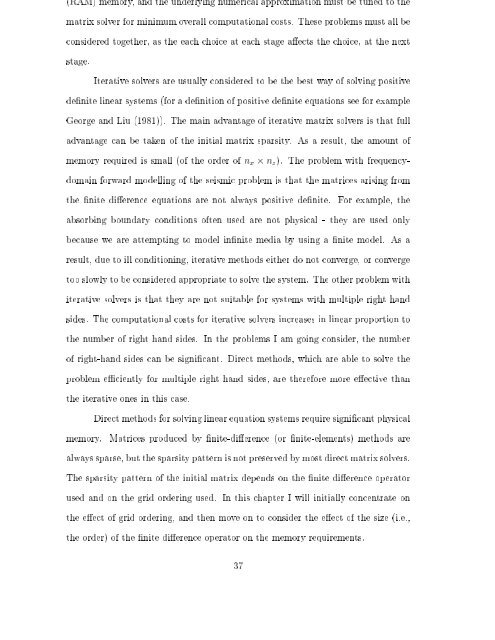Frequency domain seismic forward modelling: A tool for waveform ...
Frequency domain seismic forward modelling: A tool for waveform ...
Frequency domain seismic forward modelling: A tool for waveform ...
Create successful ePaper yourself
Turn your PDF publications into a flip-book with our unique Google optimized e-Paper software.
(RAM) memory, andtheunderlying numerical approximation must betuned tothe<br />
matrix solver <strong>for</strong> minimum overall computational costs. These problems must all be<br />
considered together, as the each choice at each stage aects the choice, at the next<br />
stage.<br />
Iterative solvers are usually considered to be the best way of solving positive<br />
denite linear systems (<strong>for</strong> a denition of positive denite equations see <strong>for</strong> example<br />
George and Liu (1981)). The main advantage of iterative matrix solvers is that full<br />
advantage can be taken of the initial matrix sparsity. As a result, the amount of<br />
memory required is small (of the order of n x n z ). The problem with frequency<strong>domain</strong><br />
<strong><strong>for</strong>ward</strong> <strong>modelling</strong> of the <strong>seismic</strong> problem is that the matrices arising from<br />
the nite dierence equations are not always positive denite.<br />
For example, the<br />
absorbing boundary conditions often used are not physical - they are used only<br />
because we are attempting to model innite media by using a nite model. As a<br />
result, due to ill conditioning, iterative methods either do not converge, or converge<br />
too slowly to be considered appropriate to solve the system. The other problem with<br />
iterative solvers is that they are not suitable <strong>for</strong> systems with multiple right hand<br />
sides. The computational costs <strong>for</strong> iterative solvers increases in linear proportion to<br />
the number of right hand sides. In the problems I am going consider, the number<br />
of right-hand sides can be signicant. Direct methods, which are able to solve the<br />
problem eciently <strong>for</strong> multiple right hand sides, are there<strong>for</strong>e more eective than<br />
the iterative ones in this case.<br />
Direct methods <strong>for</strong> solving linear equation systems require signicantphysical<br />
memory.<br />
Matrices produced by nite-dierence (or nite-elements) methods are<br />
always sparse, but the sparsity pattern is not preserved by most direct matrix solvers.<br />
The sparsity pattern of the initial matrix depends on the nite dierence operator<br />
used and on the grid ordering used. In this chapter I will initially concentrate on<br />
the eect of grid ordering, and then move on to consider the eect of the size (i.e.,<br />
the order) of the nite dierence operator on the memory requirements.<br />
37

















